Impact of Different Regulatory Structures on the Management of Energy Communities
Abstract
1. Introduction
1.1. Context
1.2. State of the Art—Justification of the Article and Main Contributions
- Compare the differences between different remuneration schemes, both in economic performance and in energy management.
- Provide evidence that considering the regulatory constraints is essential at analyzing distributed generation facilities.
1.3. Methodology
2. Model Description
2.1. Physical Model
2.2. Operating Costs
2.3. Consumers’ Energy Bill Structure
2.4. Consumers’ Energy Bill According to the Regulatory Structure Used to Promote Energy Communities
2.4.1. Setting the Context
2.4.2. Feed-in Tariff
2.4.3. Net Metering
2.4.4. Self-Consumption
2.5. Objective Function
2.6. Constraints
2.6.1. Energy Balances and Limits
2.6.2. Energy Storage Constraints
2.6.3. Energy Costs and Billing Constraints
3. Case study
3.1. Physical Conditions
3.1.1. Maximum Aggregated Energy Produced by the Energy Community
3.1.2. Aggregated Hourly Energy Consumption of the Energy Community
- If the appliance is on stand-by and consumes a minimal power.
- Otherwise, if the device is on and consumes an energy equal to , with the time step
- is generated with a standard uniform distribution between 0 and 1 and e is only evaluated for the combination of appliances previously found.
3.1.3. Battery Model
3.2. Economic Conditions
3.2.1. Electricity Market Prices
3.2.2. Electricity Billing Access Tariffs
3.2.3. Electricity Billing under Feed-in Tariff and Net Metering
3.2.4. Electricity Billing under Self-Consumption Regulatory Structure
3.2.5. O&M Costs
3.3. Data Summary
4. Results
4.1. Energy Management Results with ESS
4.1.1. Feed-in Tariff Scheme
4.1.2. Net Metering Results
4.1.3. Self-Consumption Results
4.2. Energy Management Results without ESS
4.3. Economic Results
5. Discussion
5.1. Regarding the Energy Management and the Economic Results of the Energy Community
- There might be a link between the type of energy supply (single period or multiple periods) and the regulatory structure.
- In terms of EBITDA’s income statement, the energy community with ESS reaches the best economics results.
5.2. Regarding the Impact on the Grid
5.3. Regarding the Sizing of the Energy Asset
6. Conclusions
Author Contributions
Funding
Conflicts of Interest
Nomenclature
| General | |
| CEL | Cost of energy loss |
| DER | Distributed energy resources |
| EMS | Energy Management system |
| ESS | Energy Storage System |
| FiT | Feed-in-Tariff scheme |
| HNM/DNM | Hourly/Daily net metering |
| MILP | Mixed Integer Linear Program |
| O&M | Operation and Maintenance |
| RES | Renewable Energy Sources |
| RES_E | Electricity from renewable energy sources |
| SF_A/SF_B | Self-consumption scheme types A/B |
| SP/MP | Single-period/Multi-period billing |
| Mathematical program | |
| A | Prefix which indicates aggregated or values relating to the whole community. For example, AEHC means aggregate consumption of the community |
| CHSA | Auxiliary services consumption |
| CFG_AU | Fixed operation and maintenance costs |
| CVG_AU | Variable operation and maintenance costs |
| EBITDARS/CS | Earning Before Interests, Taxes, Depreciation and Amortization for the regulatory scheme (RS) and for the conventional system (CS) |
| EG | Energy supplied by the electrical grid |
| EHC | Energy consumption |
| EP | Equivalent energy price |
| ER | Energy produced by RES |
| ER_Max | Maximum potential of RES |
| ESC/ESD | Energy charged/discharged by the ESS |
| EtG | Energy exported to the electrical grid |
| Ex_Grid | Exchange of energy with the grid |
| Ex_RES_ESS | Exchange of energy with the set composed by RES and ESS |
| IMP_ENG | Taxes related to the energy sale |
| M | Constant with an arbitrary high value |
| Nbat | Battery efficiency |
| Pc/Ec | Power/Energy charges of the self-consumption scheme |
| PCon | Contracted power |
| Pm | Day-ahead electricity market price |
| S | Stored energy in the ESS |
| S0 | Initial charge of the battery |
| SoC | State of Charge of the ESS |
| Status | Binary variable which indicates the mode of operation of the battery |
| Tp/T_FP | Power term of the access tariff/Overall cost of the power term |
| Te/T_FE | Energy term of the access tariff/Overall cost of the energy term |
| X_Y | Energy flow from X to Y. For example, EG_EHC is the energy flow from grid to consumption |
References
- Gangale, F.; Vasiljevska, J.; Covrig, F.; Mengolini, A.; Fulli, G. Smart Grid Projects Outlook 2017: Facts, Figures and Trends in Europe; Publications Office of the European Union: Luxembourg, 2017; pp. 31–32. [Google Scholar] [CrossRef]
- Koirala, B.P.; Koliou, E.; Friege, J.; Hakvoort, R.A.; Herder, P.M. Energetic Communities for Community Energy: A Review of Key Issues and Trends Shaping Integrated Community Energy Systems. Renew. Sustain. Energy Rev. 2016, 56, 722–744. [Google Scholar] [CrossRef]
- Lindquist, H. The Journey of Reinventing the European Electricity Landscape—Challenges and Pioneers. In Renewable Energy Integration; Jones, L.E., Ed.; Academic Press: Cambridge, MA, USA, 2014; Chapter 1; pp. 3–12. [Google Scholar]
- Haas, R.; Panzer, C.; Resch, G.; Ragwitz, M.; Reece, G.; Held, A. A historical review of promotion strategies for electricity from renewable energy sources in EU countries. Renew. Sustain. Energy Rev. 2011, 15, 1003–1034. [Google Scholar] [CrossRef]
- Mancarella, P. MES (Multi-Energy Systems): An Overview of Concepts and Evaluation Models. Energy 2014, 65, 1–17. [Google Scholar] [CrossRef]
- Gui, E.M.; MacGill, I. Typology of future clean energy communities: An exploratory structure, opportunities and challenges. Energy Res. Soc. Sci. 2018, 35, 94–107. [Google Scholar] [CrossRef]
- Hossain, E.; Kabalci, E.; Bayindir, R.; Perez, R. Microgrid Testbeds around the World: State of Art. Energy Convers. Manag. 2014, 86, 132–153. [Google Scholar] [CrossRef]
- Romero-Rubio, C.; de Andrés Díaz, J.R. Sustainable Energy Communities: A Study Contrasting Spain and Germany. Energy Policy 2015, 85, 397–409. [Google Scholar] [CrossRef]
- Alarcon-Rodriguez, A.; Ault, G.; Galloway, S. Multi-Objective Planning of Distributed Energy Resources: A Review of the State-of-the-Art. Renew. Sustain. Energy Rev. 2010, 14, 1353–1366. [Google Scholar] [CrossRef]
- Orehounig, K.; Mavromatidis, G.; Evins, R.; Dorer, V.; Carmeliet, J. Towards an Energy Sustainable Community: An Energy System Analysis for a Village in Switzerland. Energy Build. 2014, 84, 277–286. [Google Scholar] [CrossRef]
- Xu, X.; Jin, X.; Jia, H.; Yu, X.; Li, K. Hierarchical Management for Integrated Community Energy Systems. Appl. Energy 2015, 160, 231–243. [Google Scholar] [CrossRef]
- Wang, H.; Abdollahi, E.; Lahdelma, R.; Jiao, W.; Zhou, Z. Modelling and Optimization of the Smart Hybrid Renewable Energy for Communities (SHREC). Renew. Energy 2015, 84, 114–123. [Google Scholar] [CrossRef]
- Verschae, R.; Kawashima, H.; Kato, T.; Matsuyama, T. Coordinated Energy Management for Inter-Community Imbalance Minimization. Renew. Energy 2016, 87, 922–935. [Google Scholar] [CrossRef]
- Awad, H.; Gül, M. Optimisation of community shared solar application in energy efficient communities. Sustain. Cities Soc. 2018, 43, 221–237. [Google Scholar] [CrossRef]
- Arghandeh, R.; Woyak, J.; Onen, A.; Jung, J.; Broadwater, R.P. Economic Optimal Operation of Community Energy Storage Systems in Competitive Energy Markets. Appl. Energy 2014, 135, 71–80. [Google Scholar] [CrossRef]
- Parra, D.; Gillott, M.; Norman, S.A.; Walker, G.S. Optimum Community Energy Storage System for PV Energy Time-Shift. Appl. Energy 2015, 137, 576–587. [Google Scholar] [CrossRef]
- Barbour, E.; Parra, D.; Awwad, Z.; González, M.C. Community Energy Storage: A smart choice for the smart grid? Appl. Energy 2018, 212, 489–497. [Google Scholar] [CrossRef]
- Gaiser, K.; Stroeve, P. The Impact of Scheduling Appliances and Rate Structure on Bill Savings for Net-Zero Energy Communities: Application to West Village. Appl. Energy 2014, 113, 1586–1595. [Google Scholar] [CrossRef]
- Bracco, S.; Delfino, F.; Pampararo, F.; Robba, M.; Rossi, M. A Mathematical Model for the Optimal Operation of the University of Genoa Smart Polygeneration Microgrid: Evaluation of Technical, Economic and Environmental Performance Indicators. Energy 2014, 64, 912–922. [Google Scholar] [CrossRef]
- Erdinc, O. Economic Impacts of Small-Scale Own Generating and Storage Units, and Electric Vehicles under Different Demand Response Strategies for Smart Households. Appl. Energy 2014, 126, 142–150. [Google Scholar] [CrossRef]
- Craparo, E.; Karatas, M.; Singham, D.I. A robust optimization approach to hybrid microgrid operation using ensemble weather forecasts. Appl. Energy 2017, 201, 135–147. [Google Scholar] [CrossRef]
- Charitopoulos, V.M.; Dua, V. A unified framework for model-based multi-objective lineaer process and energy optimization under uncertainty. Appl. Energy 2017, 186, 539–548. [Google Scholar] [CrossRef]
- Marzband, M.; Sumper, A.; Domínguez-García, J.L.; Gumara-Ferret, R. Experimental Validation of a Real Time Energy Management System for Microgrids in Islanded Mode Using a Local Day-Ahead Electricity Market and MINLP. Energy Convers. Manag. 2013, 76, 314–322. [Google Scholar] [CrossRef]
- Rogers, J.C.; Simmons, E.A.; Convery, I.; Weatherall, A. Public Perceptions of Opportunities for Community-Based Renewable Energy Projects. Energy Policy 2008, 36, 4217–4226. [Google Scholar] [CrossRef]
- Nolden, C. Governing Community Energy-Feed-in Tariffs and the Development of Community Wind Energy Schemes in the United Kingdom and Germany. Energy Policy 2013, 63, 543–552. [Google Scholar] [CrossRef]
- Parajuli, R. Looking into the Danish Energy System: Lesson to Be Learned by Other Communities. Renew. Sustain. Energy Rev. 2012, 16, 2191–2199. [Google Scholar] [CrossRef]
- Dóci, G.; Gotchev, B. When Energy Policy Meets Community: Rethinking Risk Perceptions of Renewable Energy in Germany and the Netherlands. Energy Res. Soc. Sci. 2016, 22, 26–35. [Google Scholar] [CrossRef]
- Mey, F.; Diesendorf, M.; MacGill, I. Can Local Government Play a Greater Role for Community Renewable Energy? A Case Study from Australia. Energy Res. Soc. Sci. 2016, 21, 33–43. [Google Scholar] [CrossRef]
- Roby, H.; Dibb, S. Future Pathways to Mainstreaming Community Energy. Energy Policy 2019, 135, 111020. [Google Scholar] [CrossRef]
- Campos, I.; Pontes Luz, G.; Marín-González, E.; Gährs, S.; Hall, S.; Holstenkamp, L. Regulatory challenges and opportunities for collective renewable energy prosumers in the EU. Energy Policy 2019, 138, 111212. [Google Scholar] [CrossRef]
- Husein, M.; Chung, I.Y. Optimal design and financial feasibility of a university campus microgrid considering renewable energy incentives. Appl. Energy 2018, 225, 273–289. [Google Scholar] [CrossRef]
- Nguyen, S.; Peng, W.; Sokolowski, P.; Alahakoon, D.; Yu, X. Optimizing rooftop photovoltaic distributed generation with battery storage for peer-to-peer energy trading. Appl. Energy 2018, 228, 2567–2580. [Google Scholar] [CrossRef]
- Ramos-Teodoro, J.; Rodríguez, F.; Berenguel, M.; Torres, J.L. Heterogeneous resource management in energy hubs with self-consumption: Contributions and application example. Appl. Energy 2018, 229, 537–550. [Google Scholar] [CrossRef]
- De la Hoz, J.; Martín, H.; Alonso, À.; Carolina Luna, A.; Matas, J.; Vasquez, J.C.; Guerrero, J.M. Regulatory-framework-embedded energy management system for microgrids: The case study of the Spanish self-consumption scheme. Appl. Energy 2019, 251, 113374. [Google Scholar] [CrossRef]
- Manual de la Energía—Energía y Sociedad. Mecanismos de Apoyo a las Energías Renovables. Available online: http://www.energiaysociedad.es/manenergia/manual-de-la-energia/ (accessed on 23 January 2020).
- Luna, A.C.; Diaz, N.L.; Graells, M.; Vasquez, J.C.; Guerrero, J.M. Mixed- Integer-Linear-Programming Based Energy Management System for Hybrid PV wind- battery Microgrids: Modelling, Design and Experimental Verification. IEEE Trans. Power Electr. 2017, 32, 2769–2783. [Google Scholar] [CrossRef]
- Photovoltaic Geographical Information System—European Commission. Available online: https://re.jrc.ec.europa.eu/pvg_tools/en/tools.html#MR (accessed on 10 July 2017).
- PVSyst Photovoltaic Source Component Databsase. Available online: https://www.pvsyst.com/help/pvmodule_database.htm (accessed on 10 July 2017).
- Ortiz, J.; Guarino, F.; Salom, J.; Corchero, C.; Cellura, M. Stochastic model for electrical loads in Mediterranean residential buildings: Validation and applications. Energy Build 2014, 80, 23–36. [Google Scholar] [CrossRef]
- Instituto para la Diversificacion y Ahorro de la Energía. Proyecto SECH-SPAHOUSEC: Análisis del Consumo Energético en el Sector Residencial en España; Instituto para la Diversificacion y Ahorro de la Energía: Madrid, Spain, 2011; Available online: https://www.idae.es/uploads/documentos/documentos_Informe_SPAHOUSEC_ACC_f68291a3.pdf (accessed on 2 September 2019).
- Operador del Mercado Ibérico de la Electricidad. Available online: http://www.omie.es (accessed on 10 July 2017).
- Ministerio de Industria, Energía y Turismo. Orden IET/107/2014, de 31 de enero. BOE, 01/02/2014. Available online: https://www.boe.es/diario_boe/txt.php?id=BOE-A-2014-1052 (accessed on 25 July 2017).
- Ministerio de Energía, Turismo, y Agenda Digital. Orden ETU/1976/2016, de 23 de Diciembre. BOE, 29/12/2016. Available online: https://www.boe.es/buscar/doc.php?id=BOE-A-2016-12464 (accessed on 25 July 2017).
- Instituto Para la Diversificación y Ahorro de la Energía (IDAE). Plan de Energías Renovables 2011–2020. Madrid. 2011. Available online: https://www.idae.es/tecnologias/energias-renovables/plan-de-energias-renovables-2011-2020 (accessed on 25 July 2017).
- Zakeri, B.; Syri, S. Electrical energy storage systems: A comparative life cycle cost analysis. Renew. Sustain. Energy Rev. 2014, 42, 569–596. [Google Scholar] [CrossRef]
- Ministerio de Industria, Energía y turismo. Real Decreto 900/2015, de 9 de Octubre. BOE, 10/10/2015. Available online: https://www.boe.es/diario_boe/txt.php?id=BOE-A-2015-10927 (accessed on 11 May 2020).
- López-Prol, J.; Steininger, K.W. Photovoltaic self-consumption regulation in Spain: Profitability analysis and alternative regulation schemes. Energy Policy 2017, 108, 742–754. [Google Scholar] [CrossRef]
- Londo, M.; Matton, R.; Usmani, O.; van Klaveren, M.; Tigchelaar, C.; Brunsting, S. Alternatives for current net metering policy for solar PV in the Netherlands: A comparison of impacts on business case and purchasing behaviour of private homeowners, and on governmental costs. Renew. Energy 2020, 147, 903. [Google Scholar] [CrossRef]
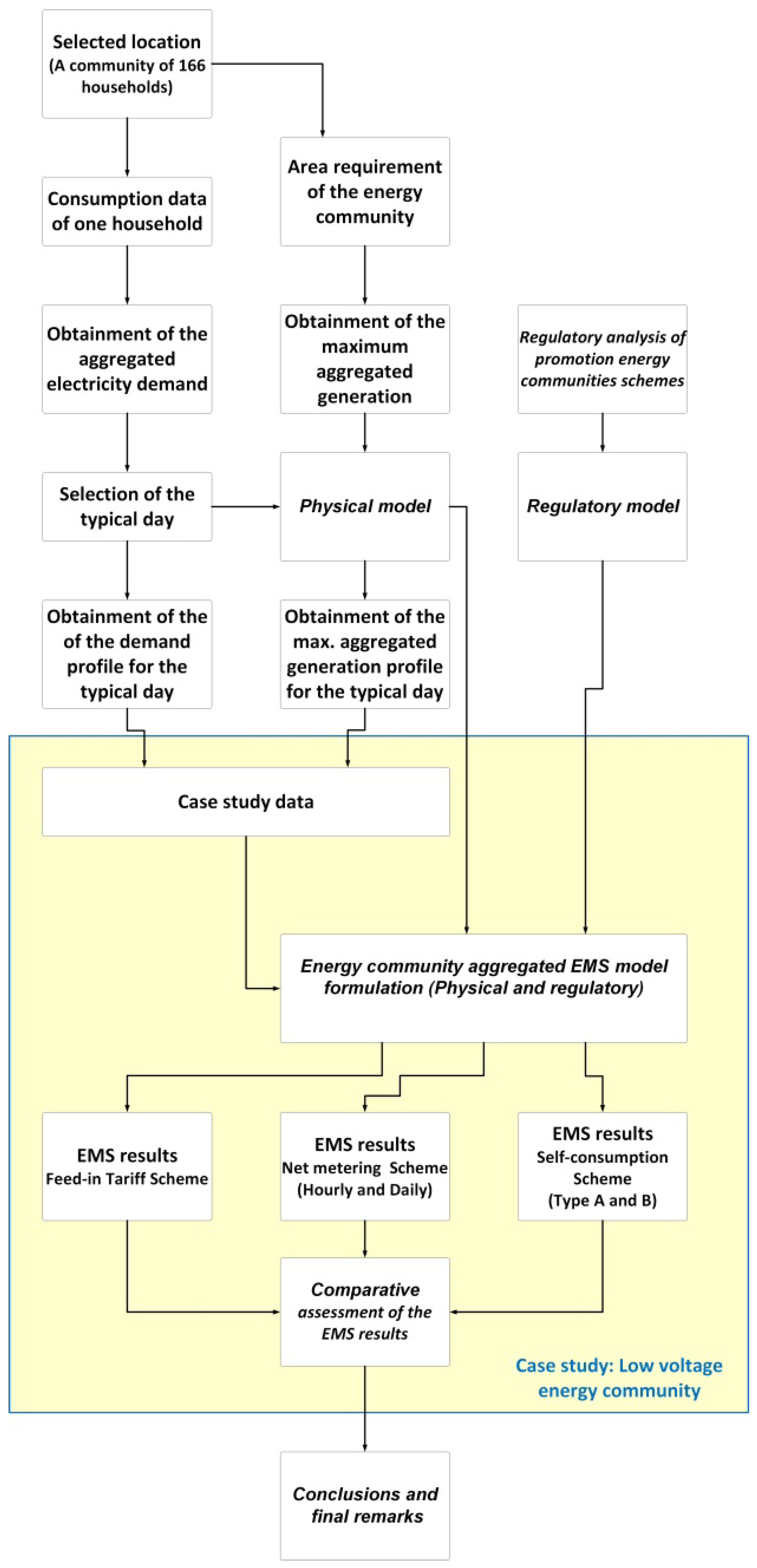
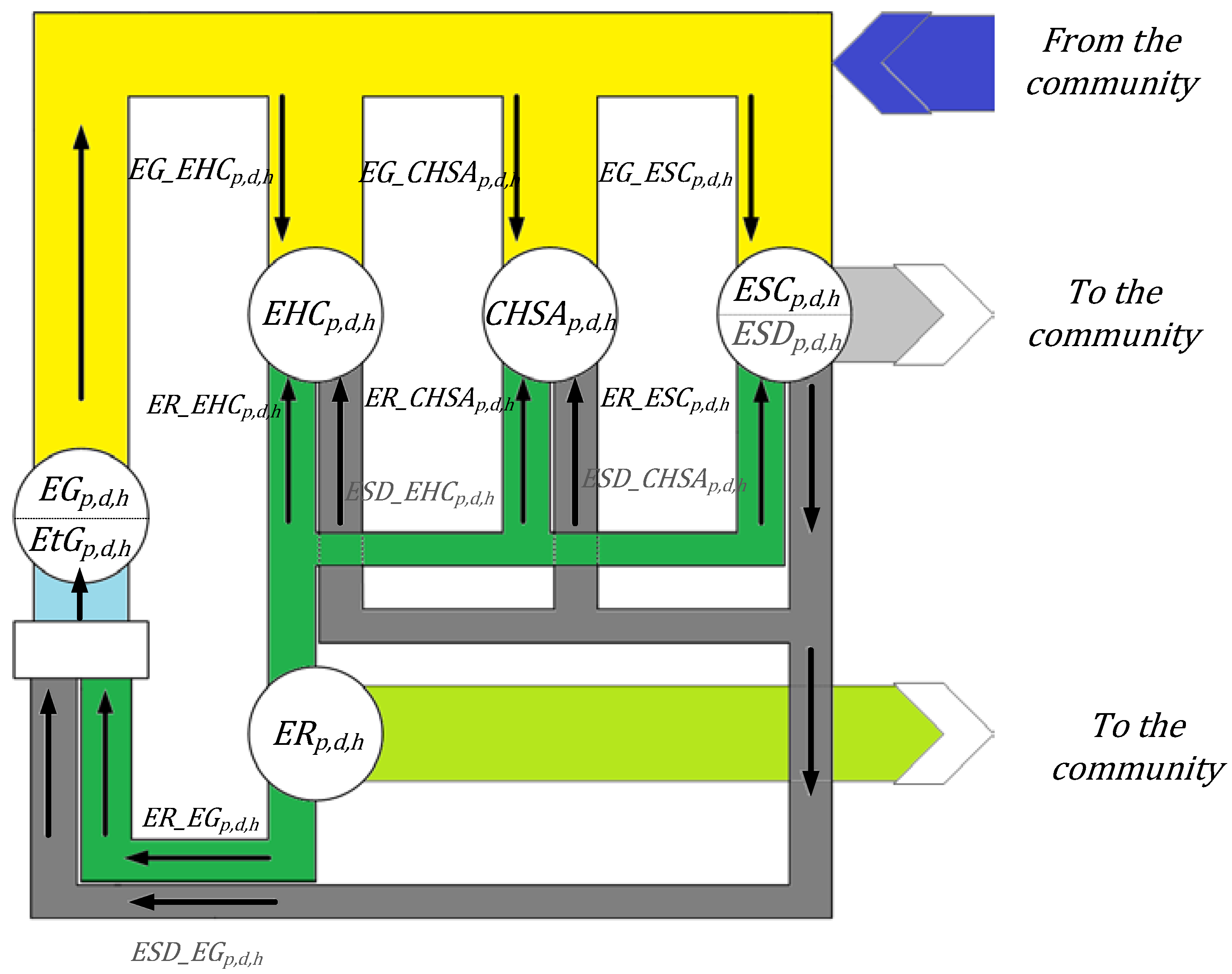
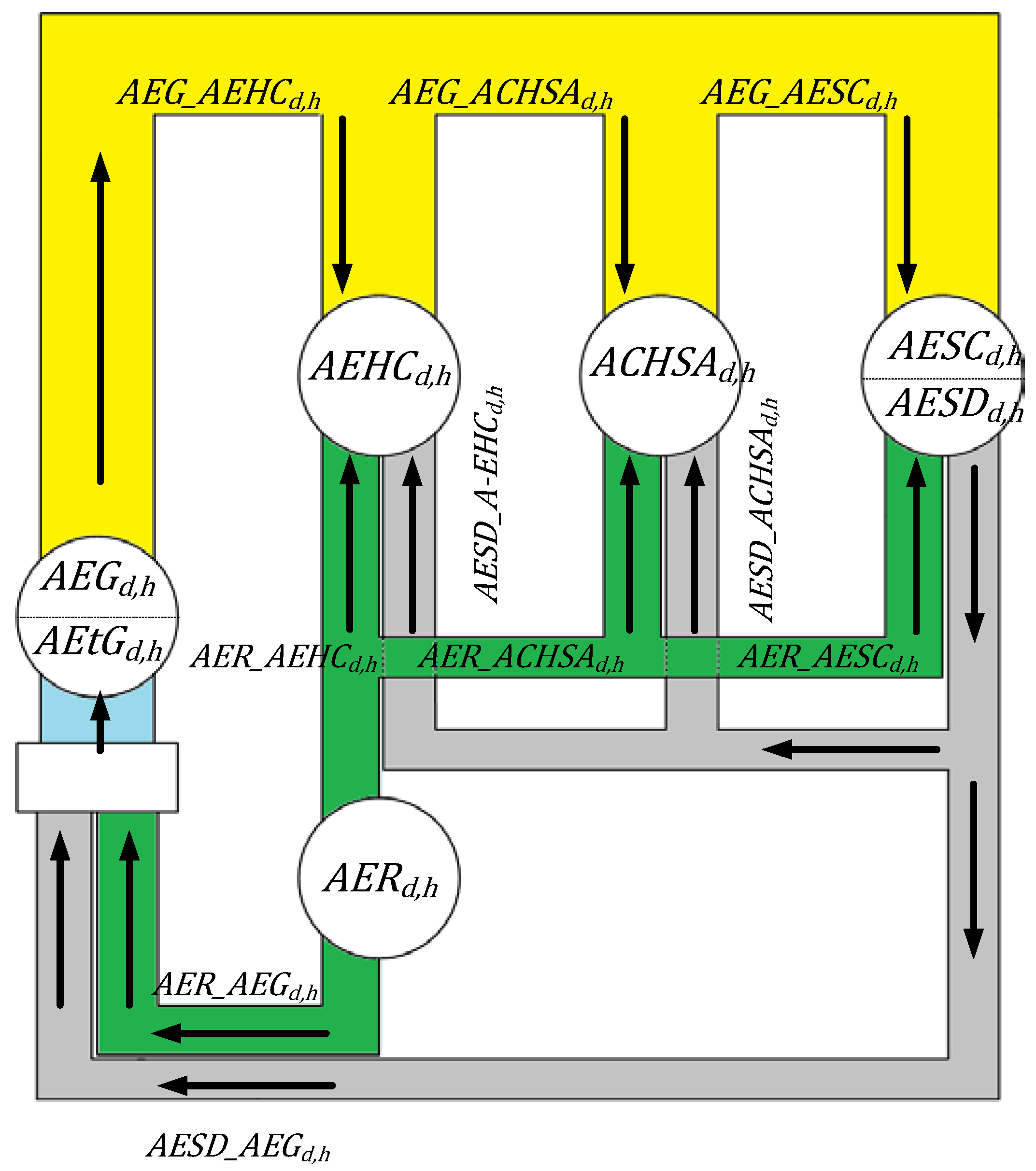
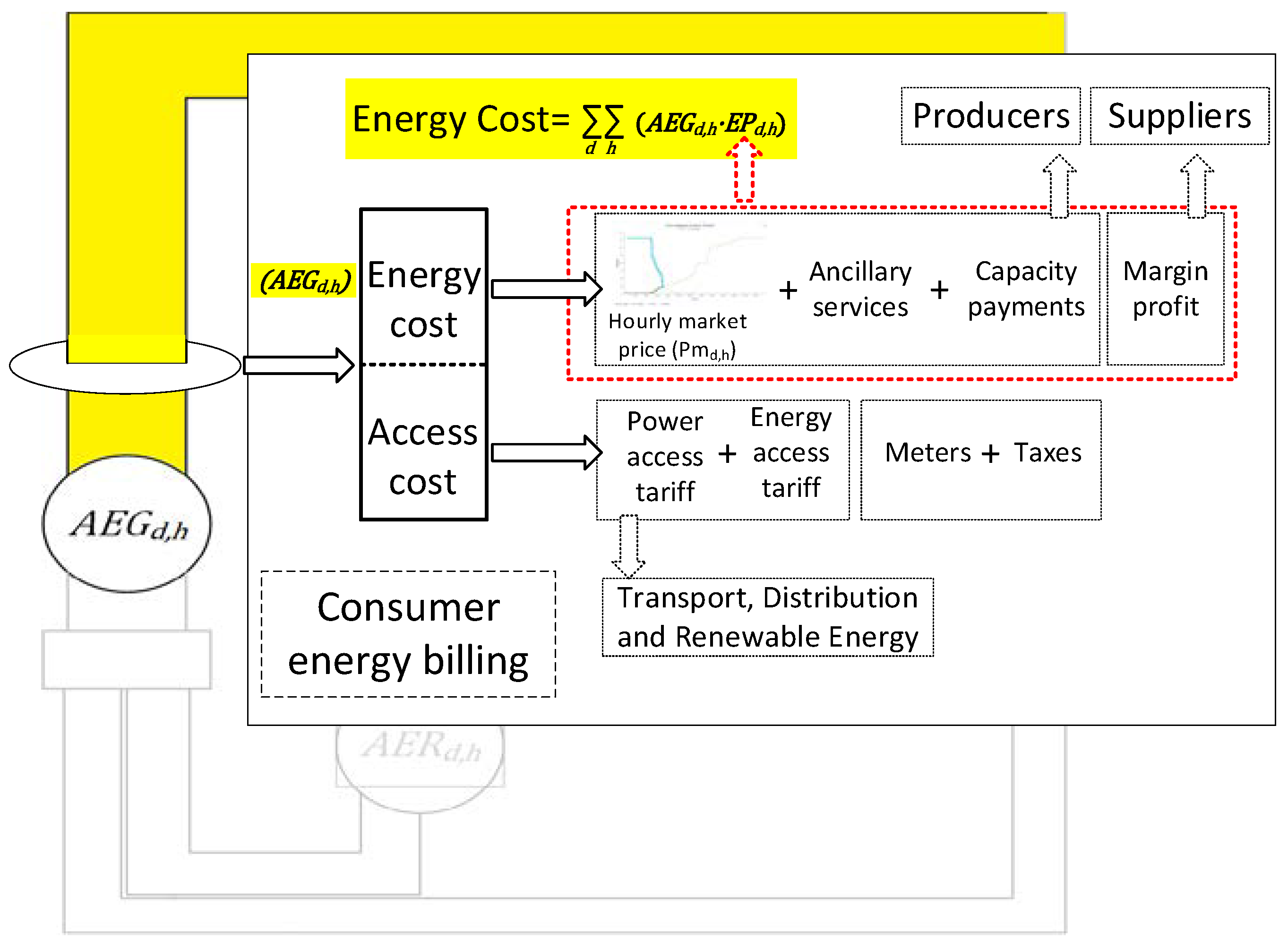
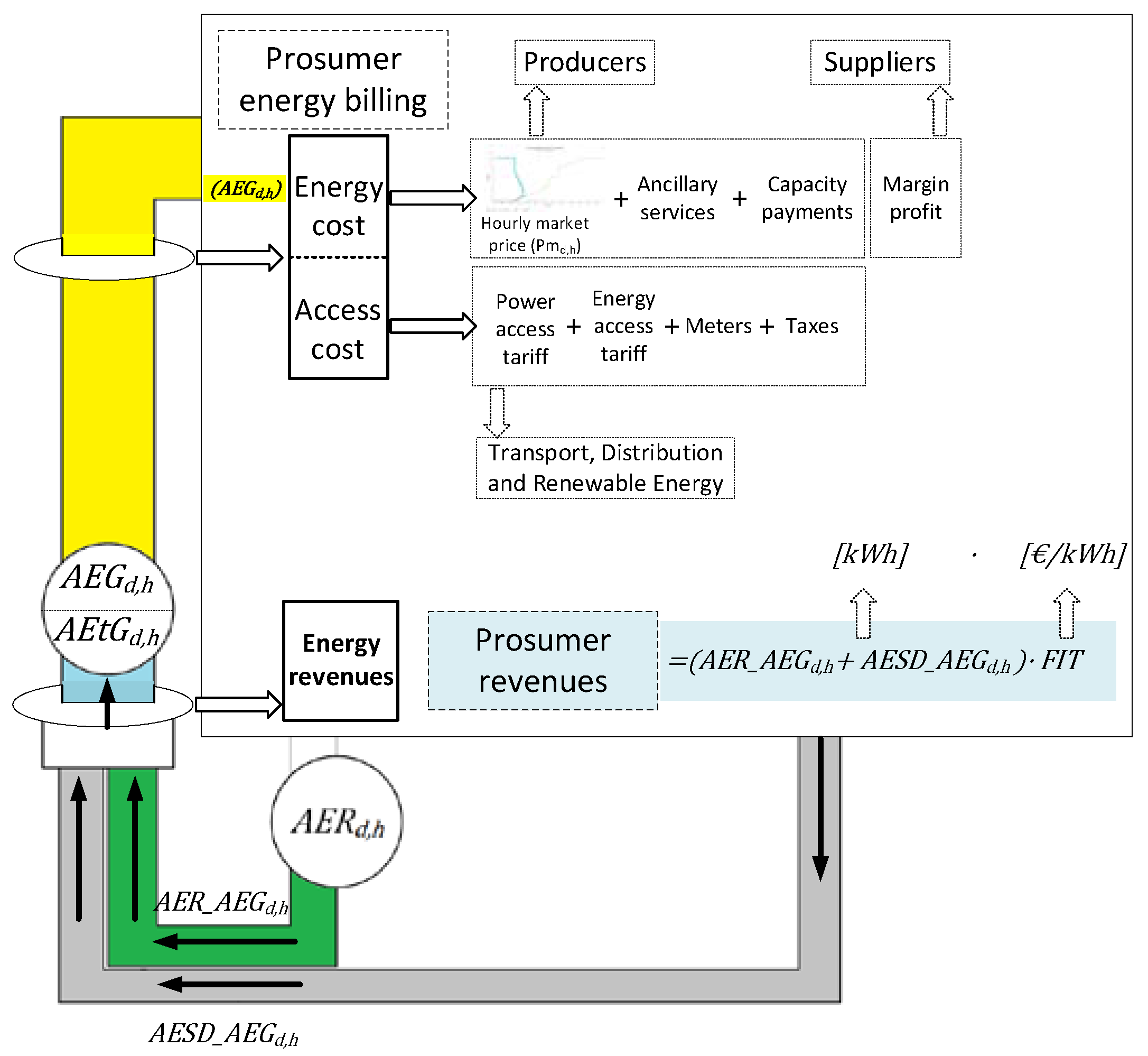
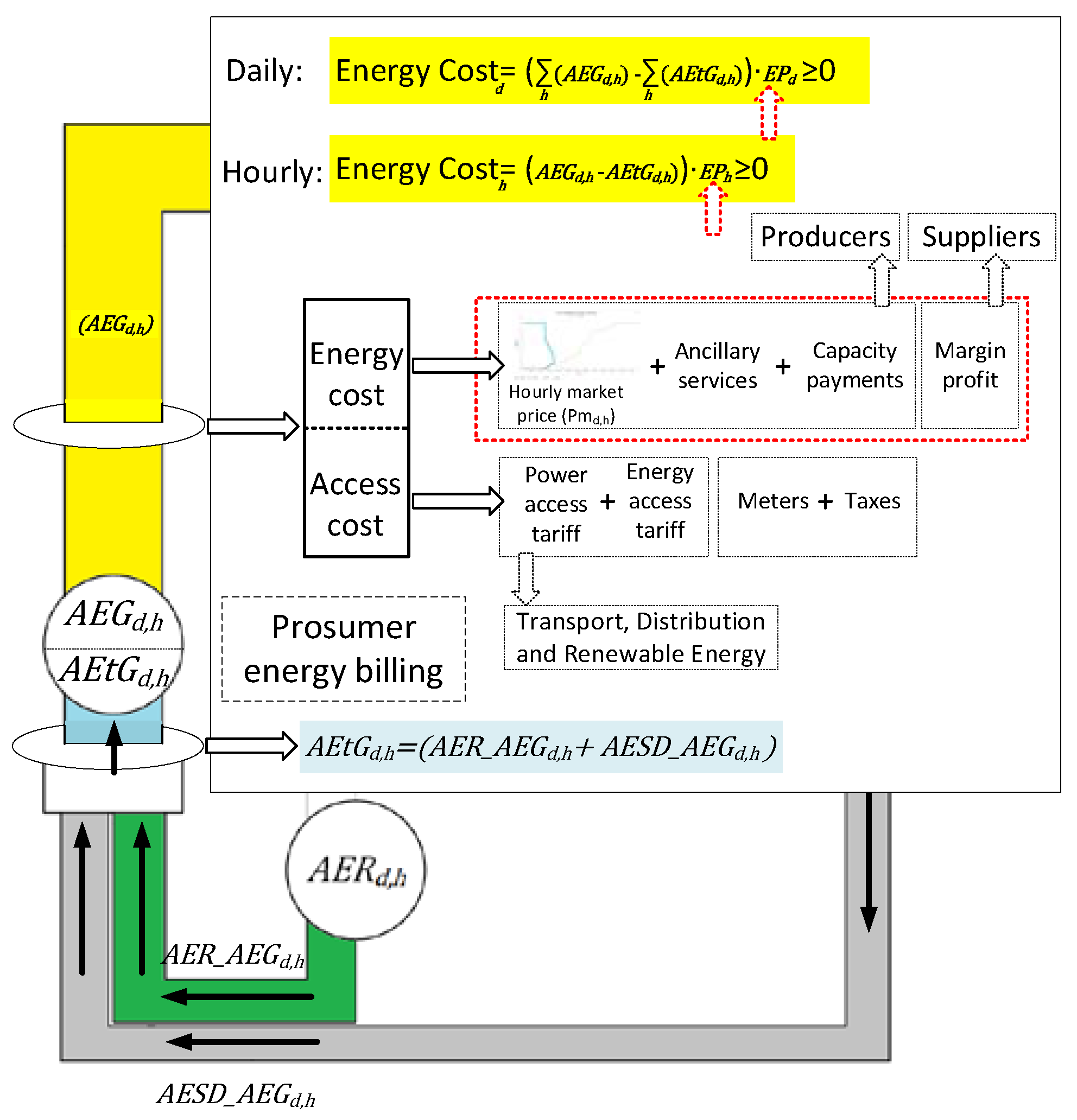
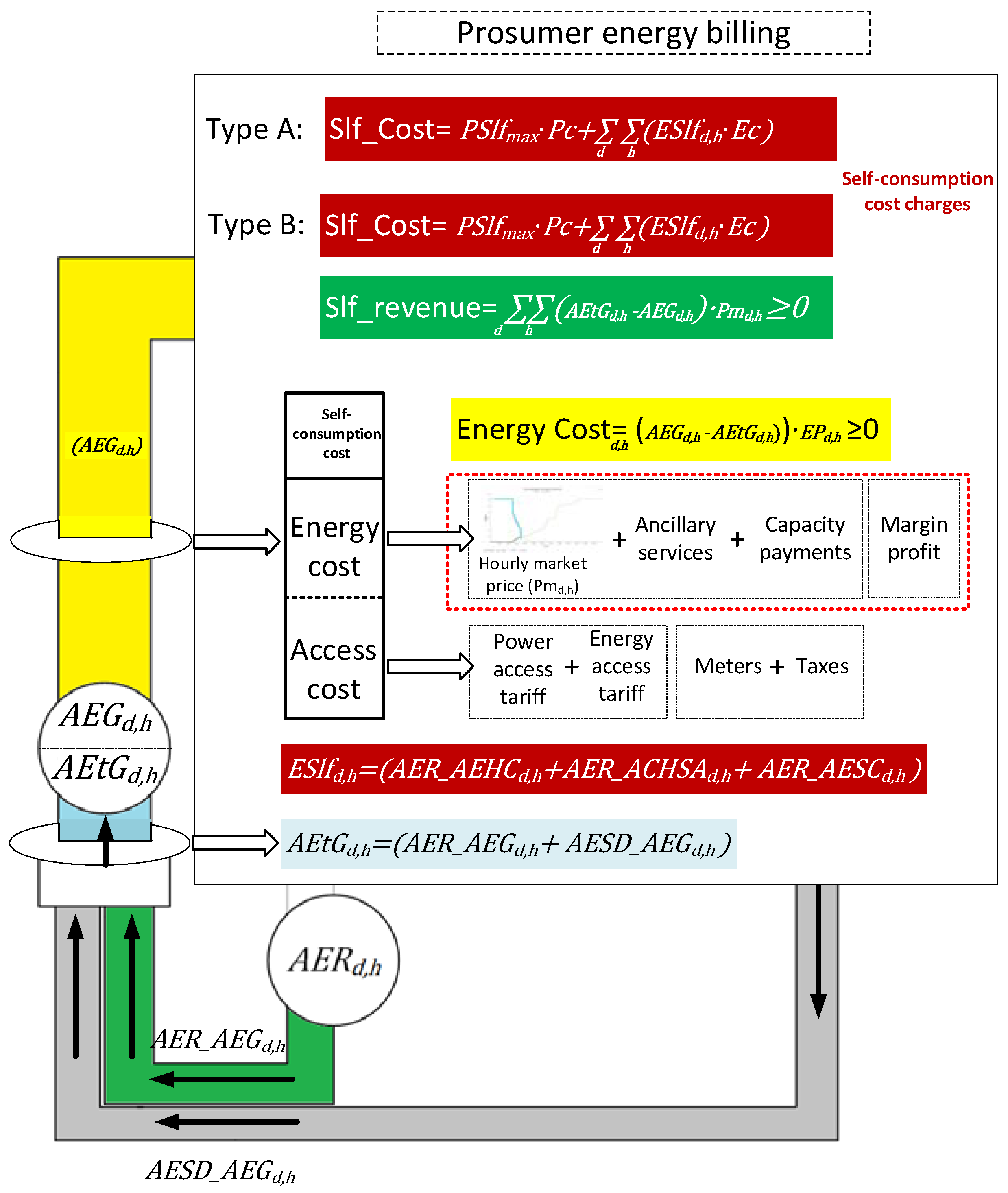



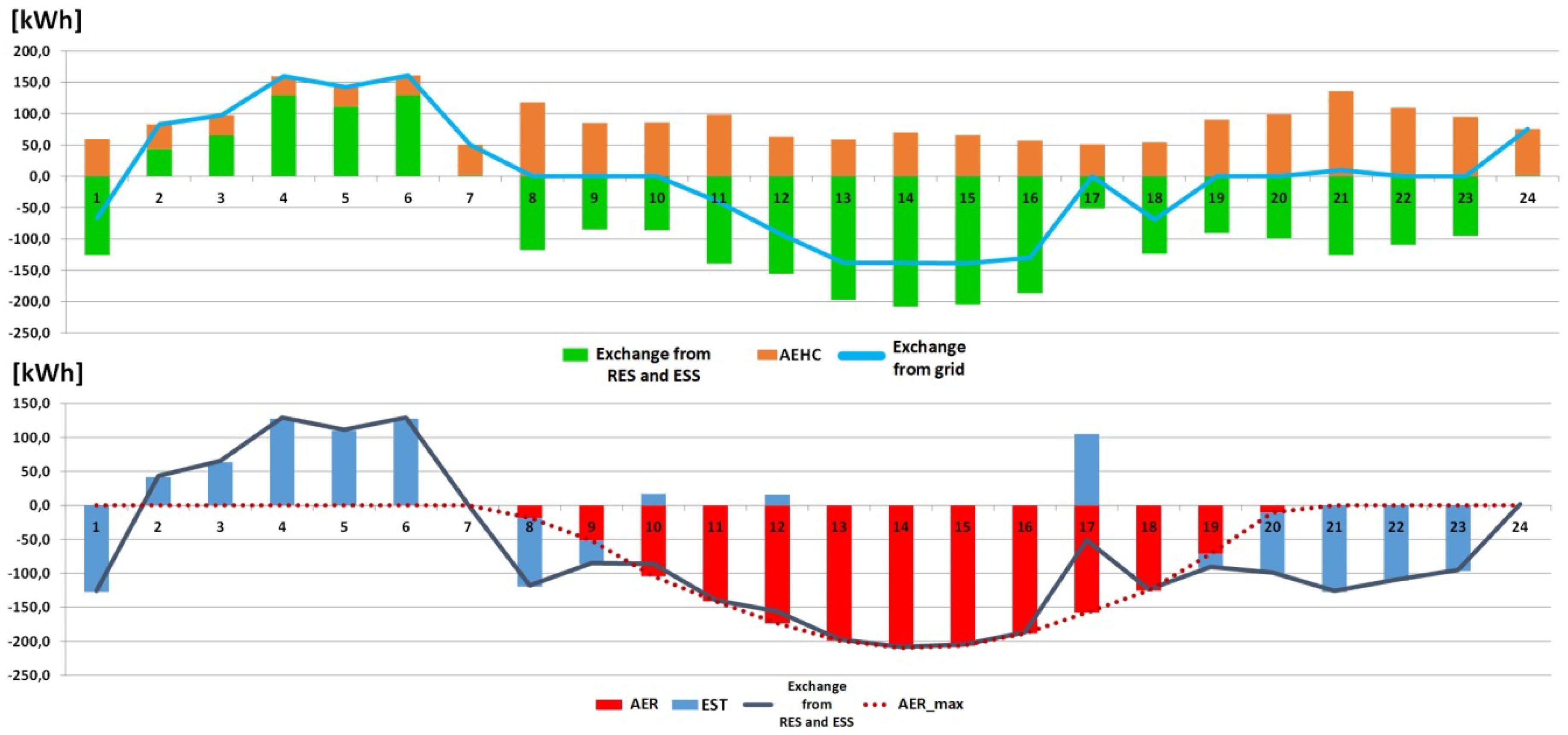
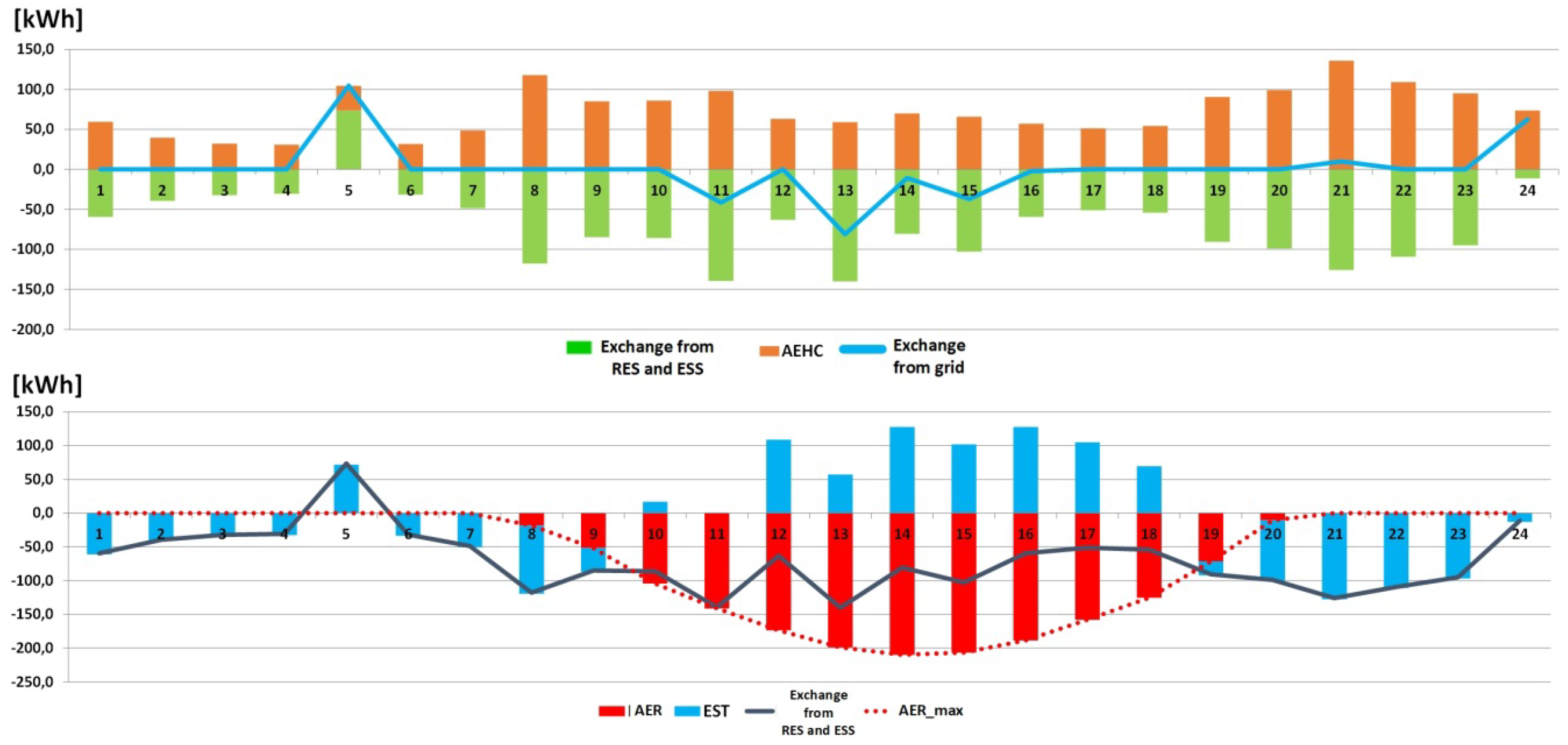
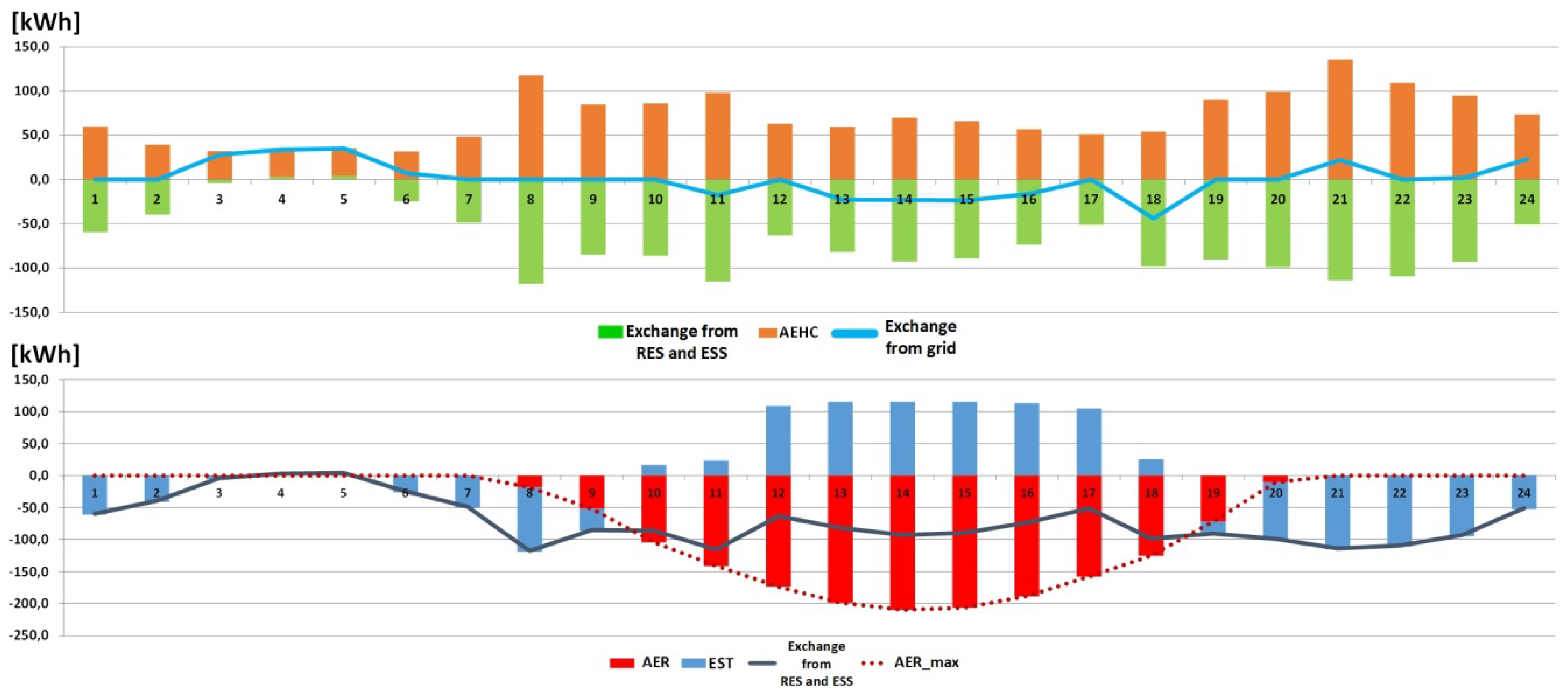
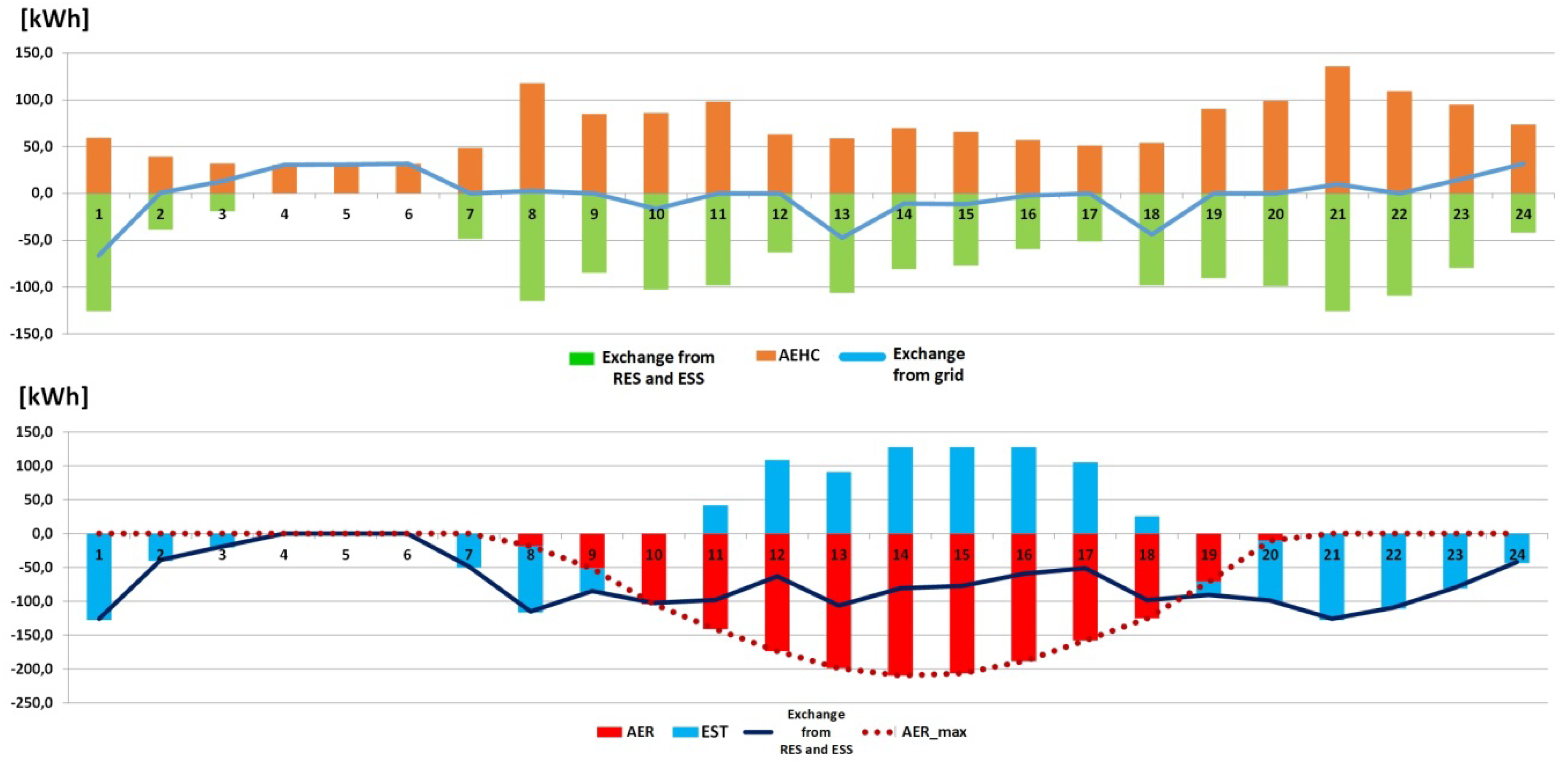
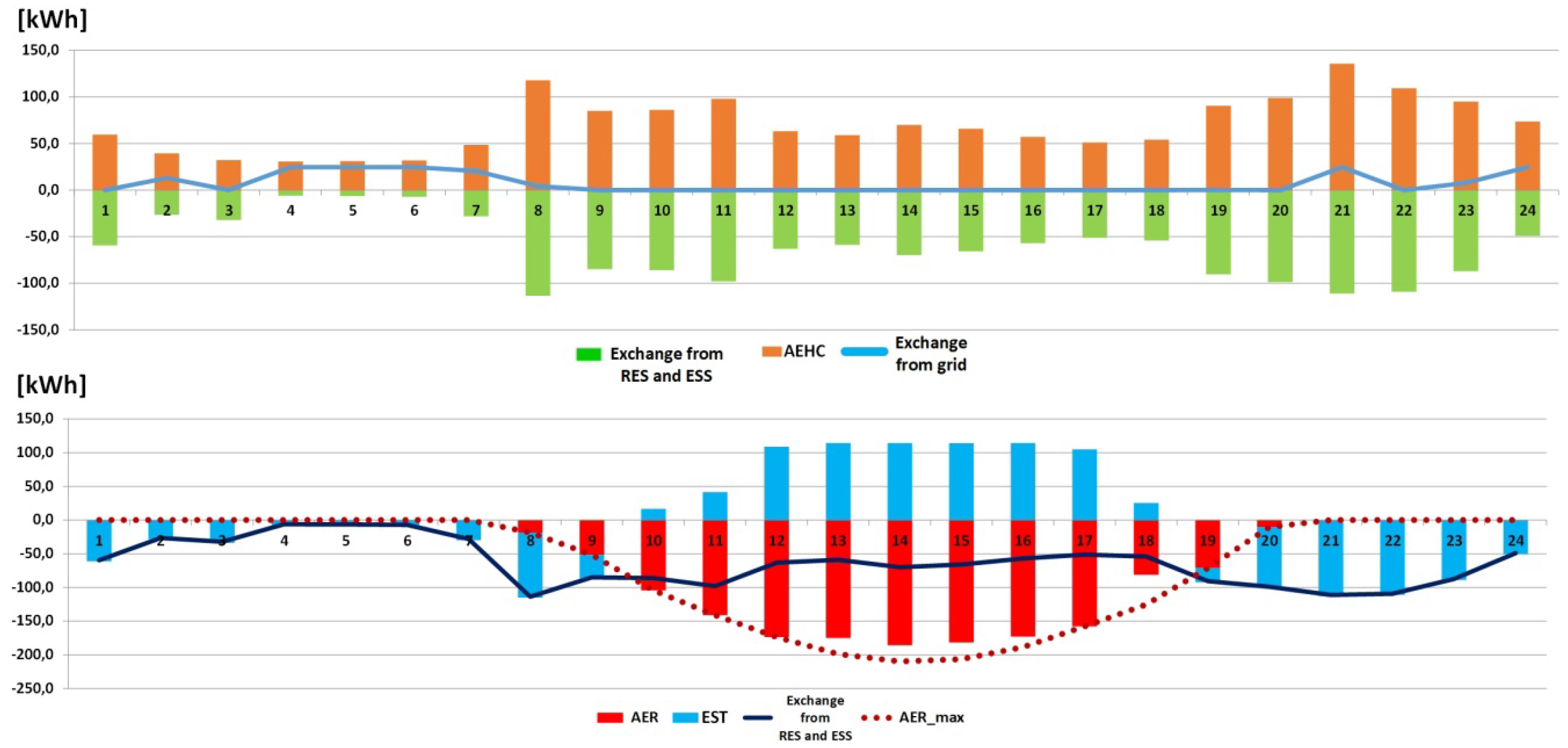
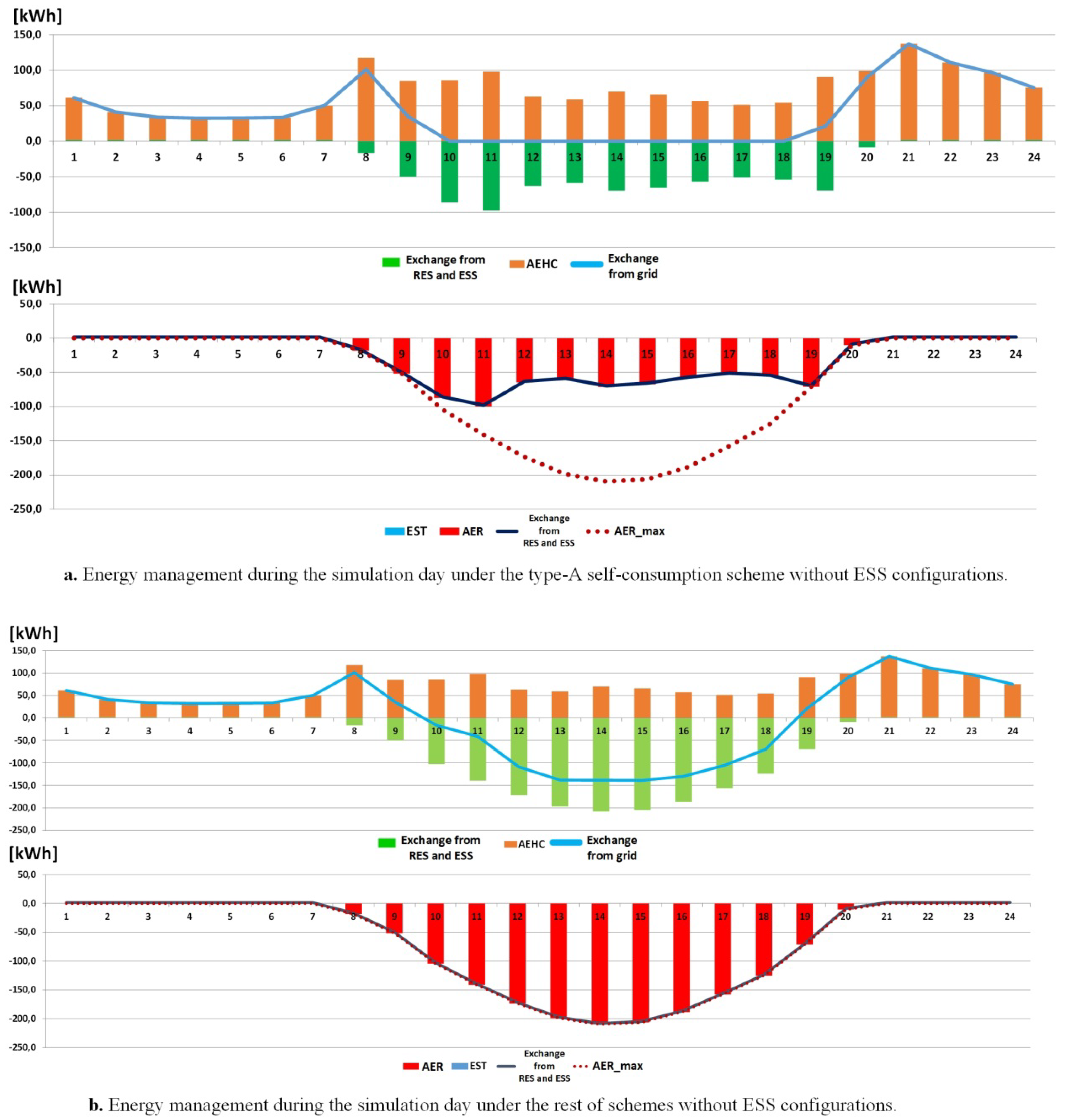
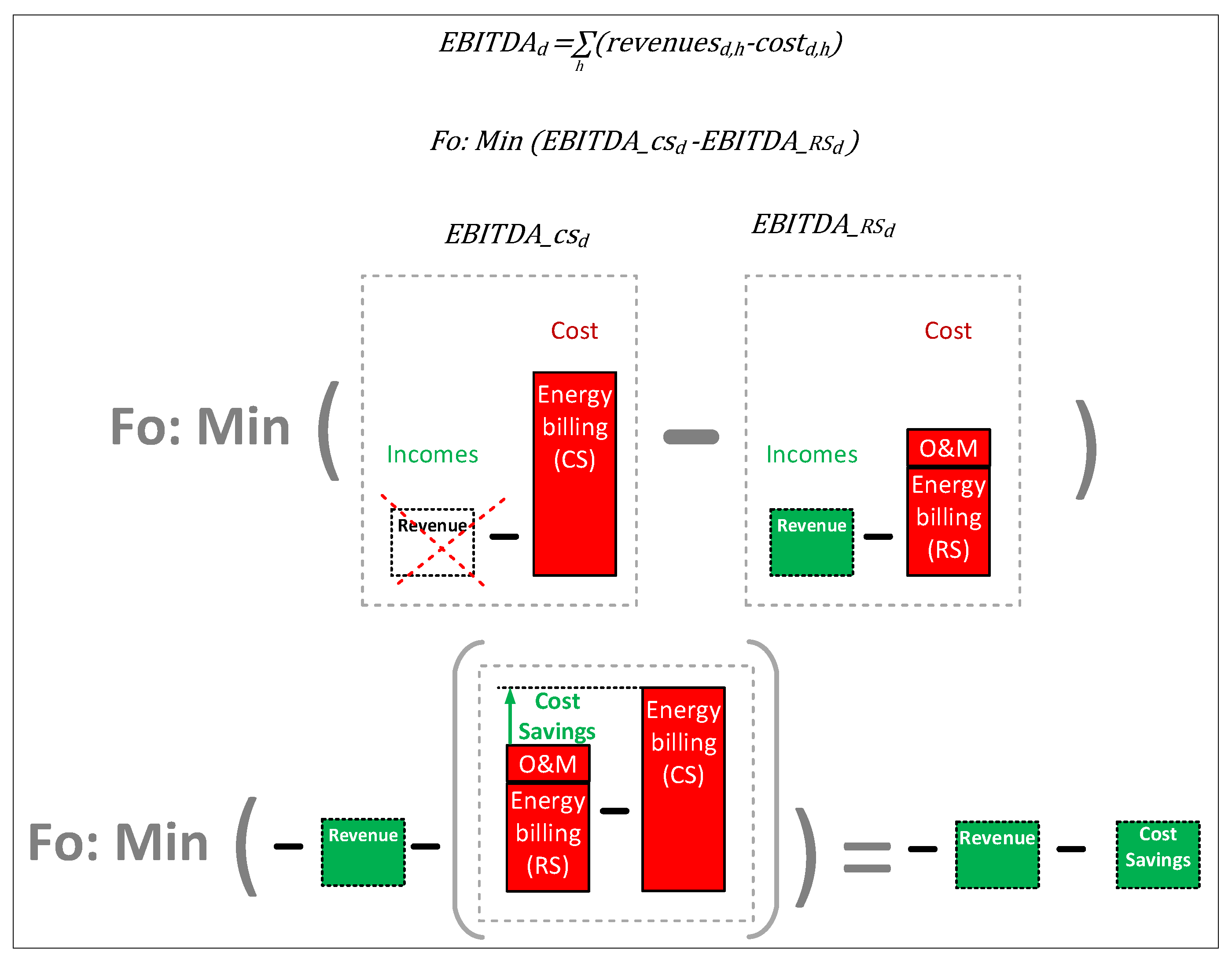
| Aggregated battery capacity | 1275 kWh |
| Aggregated maximum charge/discharge power | 127.5 kW |
| Aggregated maximum charge/discharge power at status 1 | 25.5 kW |
| Efficiency | 1 (ideal) |
| Type of Supply Contract | Single Period (SP) | Multiple Period (MP) | ||
|---|---|---|---|---|
| Access tariffs | p = 1 | p = 1 | p = 2 | p = 3 |
| Te [€/kWh] | 0.044 | 0.062 | 0.003 | 0.001 |
| Tp [€/kW·year] | 38.04 | 38.04 | 38.04 | 38.04 |
| Type of Supply Contract | Single Period (SP) | Multiple Period (MP) | ||
|---|---|---|---|---|
| Charges | p = 1 | p = 1 | p = 2 | p = 3 |
| Ec [€/kWh] | 0.043 | 0.058 | 0.006 | 0.006 |
| Pc [€/kW·year] | 8.144 | 8.144 | 8.144 | 8.144 |
| Data | Value and Units |
|---|---|
| Time step | 1 h |
| Simulation day | Typical day of September |
| Generation and consumption | |
| Peak consumption | 135.7 kW |
| Hour of peak consumption | 21 h |
| Daily consumed energy | 1683 kWh |
| Auxiliary services consumption | 1.66 kW |
| Contracted power | 381.3 kW |
| PV peak power per dwelling | 2.25 kW |
| Aggregated PV peak power | 209.8 kW |
| Aggregated generated energy | 1657 kWh |
| Energy storage | |
| Aggregated battery capacity | 1275 kWh |
| Aggregated maximum charge/discharge power | 127.5 kW |
| Aggregated maximum charge/discharge power at status 1 | 25.5 kW |
| Efficiency | 1 (ideal) |
| Depth of discharge | 80% |
| Initial State of Charge | 60% |
| Electricity billing | |
| Meter rent | 1.11 €/month |
| VAT | 21% |
| Electricity tax | 5113% |
| Electricity market price | 0.039–0.075 €/kWh |
| Power term of the access tariff | 38.04 €/kW·year |
| Energy term of the access tariff | 0.002–0.062 |
| Feed-in Tariff | 0.135 €/kWh |
| Self-consumption O&M Costs | |
| Energy sale tax | 0.5 €/MWh + 7% over the energy value |
| PV O&M costs | 36.1 €/kW·year |
| Storage O&M costs | 6.1 €/kW·year + 0.49 €/MWh |
| Energy Community with ESS | Energy Community without ESS | |||||||||||
|---|---|---|---|---|---|---|---|---|---|---|---|---|
| Type of Scheme | Type of Scheme | FiT | DNM | HNM | SF_B | SF_A | FIT | DNM | HNM | SF_B | SF_A | |
| Type of supply | SP | O. F. value | −1.31 | −1.19 | −1.10 | −0.60 | −0.56 | −1.14 | −0.84 | −0.48 | −0.15 | 0.07 |
| Overall saving results | 1.31 | 1.19 | 1.10 | 0.60 | 0.56 | 1.14 | 0.84 | 0.48 | 0.15 | −0.07 | ||
| MP | O. F. value | −1.80 | −1.07 | −0.98 | −0.65 | −0.60 | −1.17 | −0.85 | −0.45 | −0.29 | −0.07 | |
| Overall saving results | 1.80 | 1.07 | 0.98 | 0.65 | 0.60 | 1.17 | 0.85 | 0.45 | 0.29 | 0.07 | ||
| Type of Scheme | Main Features of the Energy Management |
|---|---|
| FiT | Maximises the electricity dump into the grid. Favourable hourly discrimination Reduced energy storage use |
| HNM | Electricity dump mainly without ESS Unfavourable hourly discrimination Extensive use of energy storage. A significant difference between using ESS or not |
| DNM | Similar management to hourly net metering Neuter hourly discrimination Extensive use of energy storage but the differences are not so significant. |
| SF_A | No energy dump because there is no reward Hourly discrimination slightly favourable Not profitable without ESS Energy curtail to not increase O&M costs |
| SF_B | Maximises dumping in systems without ESS Hourly discrimination somewhat favourable Extensive use of ESS if available More profitable than SF_A, but less than the other schemes |
| Energy Community with ESS | Energy Community without ESS | |||||||||||
|---|---|---|---|---|---|---|---|---|---|---|---|---|
| Type of Scheme | Type of Scheme | FiT | DNM | HNM | SF_B | SF_A | FIT | DNM | HNM | SF_B | SF_A | |
| Type of supply | SP | Difference in saving results | 134% | 113% | 96% | 7% | 0% | 1.729% | 1.300% | 786% | 314% | 0% |
| MP | Difference in saving results | 200% | 78% | 63% | 8% | 0% | 1.571% | 1.114% | 543% | 314% | 0% | |
© 2020 by the authors. Licensee MDPI, Basel, Switzerland. This article is an open access article distributed under the terms and conditions of the Creative Commons Attribution (CC BY) license (http://creativecommons.org/licenses/by/4.0/).
Share and Cite
de la Hoz, J.; Alonso, À.; Coronas, S.; Martín, H.; Matas, J. Impact of Different Regulatory Structures on the Management of Energy Communities. Energies 2020, 13, 2892. https://doi.org/10.3390/en13112892
de la Hoz J, Alonso À, Coronas S, Martín H, Matas J. Impact of Different Regulatory Structures on the Management of Energy Communities. Energies. 2020; 13(11):2892. https://doi.org/10.3390/en13112892
Chicago/Turabian Stylede la Hoz, Jordi, Àlex Alonso, Sergio Coronas, Helena Martín, and José Matas. 2020. "Impact of Different Regulatory Structures on the Management of Energy Communities" Energies 13, no. 11: 2892. https://doi.org/10.3390/en13112892
APA Stylede la Hoz, J., Alonso, À., Coronas, S., Martín, H., & Matas, J. (2020). Impact of Different Regulatory Structures on the Management of Energy Communities. Energies, 13(11), 2892. https://doi.org/10.3390/en13112892






